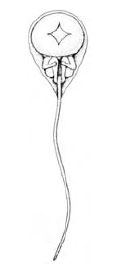Early Concepts: Preformation Versus Epigenesis
Early Concepts:
Preformation Versus
Epigenesis
Early scientists and laypeople alike
speculated at length about the mystery
of development long before the
process was submitted to modern techniques
of biochemistry, molecular biology,
tissue culture, and electron
microscopy. An early and persistent
idea was that young animals were preformed
in eggs and that development
was simply a matter of unfolding what
was already there. Some claimed they
could actually see a miniature of the
adult in the egg or sperm (Figure 8-1).
Even the more cautious argued that all
parts of the embryo were in the egg,
needing only to unfold, but so small
and transparent they could not be
seen. The concept of preformation was strongly advocated by most
seventeenth- and eighteenth-century
naturalist-philosophers.
In 1759 German embryologist Kaspar Friedrich Wolff clearly showed that in the earliest developmental stages of the chick, there was no preformed individual, only undifferentiated granular material that became arranged into layers. These layers continued to thicken in some areas, to become thinner in others, to fold, and to segment, until the body of the embryo appeared. Wolff called this process epigenesis (“origin upon or after”), an idea that a fertilized egg contains building material only, somehow assembled by an unknown directing force. Current ideas of development are essentially epigenetic in concept, although we know far more about what directs growth and differentiation.
Development describes the progressive
changes in an individual from
its beginning to maturity (Figure 8-2).
In sexual multicellular organisms,
development usually begins with a fertilized
egg that divides mitotically to
produce a many-celled embryo. These
cells then undergo extensive rearrangements
and interact with one another
to generate the animal’s body
plan and all of the many kinds of specialized
cells in the body. This generation
of cellular diversity is not defined
all at once but is formed as the result
of a hierarchy of developmental
decisions. The many familiar cell
types that make up the body do not
simply “unfold” at some point, but
arise from conditions created in preceding
stages. At each stage of development
new structures arise from the
interaction of less committed rudiments.
Each interaction is increasingly
restrictive, and the decision made at
each stage in the hierarchy further limits
developmental fate. Once cells
embark on a course of differentiation,
they become irrevocably committed to
that course. They no longer depend on
the stage that preceded them, nor do
they have the option of becoming
something different. Once a structure
becomes committed it is said to be determined. Thus the hierarchy of
commitment is progressive and it is
usually irreversible. The two basic
processes that are responsible for this
progressive subdivision are cytoplasmic
localization and induction. We
will discuss both processes as we
proceed through this section.
 |
| Figure 8-1 Preformed human infant in sperm as imagined by seventeenth-century Dutch histologist Niklass Hartsoeker, one of the first to observe sperm with a microscope of his own construction. Other remarkable pictures published during this period depicted the figure sometimes wearing a nightcap! |
In 1759 German embryologist Kaspar Friedrich Wolff clearly showed that in the earliest developmental stages of the chick, there was no preformed individual, only undifferentiated granular material that became arranged into layers. These layers continued to thicken in some areas, to become thinner in others, to fold, and to segment, until the body of the embryo appeared. Wolff called this process epigenesis (“origin upon or after”), an idea that a fertilized egg contains building material only, somehow assembled by an unknown directing force. Current ideas of development are essentially epigenetic in concept, although we know far more about what directs growth and differentiation.
 |
| Figure 8-2 Key events in animal development. |




